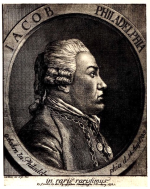Help us get to over 8,756 articles in 2024.
If you know of a magician not listed in MagicPedia, start a New Biography for them. Contact us at magicpediahelp@gmail.com
Philadelphus Philadelphia: Difference between revisions
mNo edit summary |
mNo edit summary |
||
| (One intermediate revision by one other user not shown) | |||
| Line 1: | Line 1: | ||
{{Infobox person | {{Infobox person | ||
| image = | | image = Jacob Philadelphia.png | ||
| image_size = | | image_size = | ||
| alt = | | alt = | ||
| caption = | | caption = | ||
| birth_name = Jacob Meyer | | birth_name = Jacob Meyer | ||
| birth_day = | | birth_day = August 14, | ||
| birth_year = | | birth_year = 1735 | ||
| birth_place = United States | | birth_place = United States | ||
| death_day = | | death_day = | ||
| death_year = | | death_year = 1795 | ||
| death_place = | | death_place = | ||
| resting_place = | | resting_place = | ||
| Line 21: | Line 21: | ||
| misc = | | misc = | ||
}} | }} | ||
'''Philadelphus Philadelphia''' (1735-1795), born Jacob Meyer in the United States, was a celebrated conjurer who traveled very extensively through Europe, exhibiting his tricks in all the leading cities. | '''Philadelphus Philadelphia''' (b.1735-d.1795), born Jacob Meyer in the United States, was a celebrated conjurer who traveled very extensively through Europe, exhibiting his tricks in all the leading cities. | ||
== Bibliography == | == Bibliography == | ||
Latest revision as of 12:40, 14 August 2024
| Philadelphus Philadelphia | |
 | |
| Born | Jacob Meyer August 14, 1735 United States |
|---|---|
| Died | 1795 |
Philadelphus Philadelphia (b.1735-d.1795), born Jacob Meyer in the United States, was a celebrated conjurer who traveled very extensively through Europe, exhibiting his tricks in all the leading cities.
Bibliography
Philadelphia came from a Jewish family in Philadelphia. When he converted to the Christian church he adopted the name of his native city. At an early age he showed an inclination for mathematics and physics. Meyer's patron in England was Prince Henry Frederick, Duke of Cumberland and Strathearn, for whom he performed astrology, magic, and alchemy.
He became known as Meyer Philadelphia and Philadelphus Philadelphia.
Philadelphia obtained great success on his numerous tours, and even with people of high standing he made much of a reputation. He made a great deal of money and enjoyed his trips practicing magic. He traveled throughout Europe, performed before the Empress Catharine, and won the favor of the Sultan Mustapha Third at Constantinople. Later on he had great success in Vienna and Berlin. He had difficulty with Friedrich the Great, who was alarmed after Meyer read his mind and subsequently banished the magician from Prussia.
In 1758, he toured England, although presenting himself as being a scientist, rather then a magician.
In 1774 he published 'Little Treatise on Strange and Suitable Feats', possibly the first magic book by an American-born magician.
In 1777, Georg Christoph Lichtenberg opposed the apparent misrepresentation of science by Philadelphia. Lichtenberg considered him to be a magician, not a physicist, and created a satirical poster that was intended to prevent Philadelphia from performing his exhibition in Göttingen. The placard, called "Lichtenberg's Avertissement", described extravagant and miraculous tricks that were to be performed. As a result, Philadelphia left the city without a performance.
Books
Little Treatise on Strange and Suitable Feats (1774)
References
| This page incorporated content from Jacob_Philadelphia,
a page hosted on Wikipedia. Please consult the history of the original page to see a list of its authors. Therefor, this article is also available under the Creative Commons Attribution-ShareAlike License |